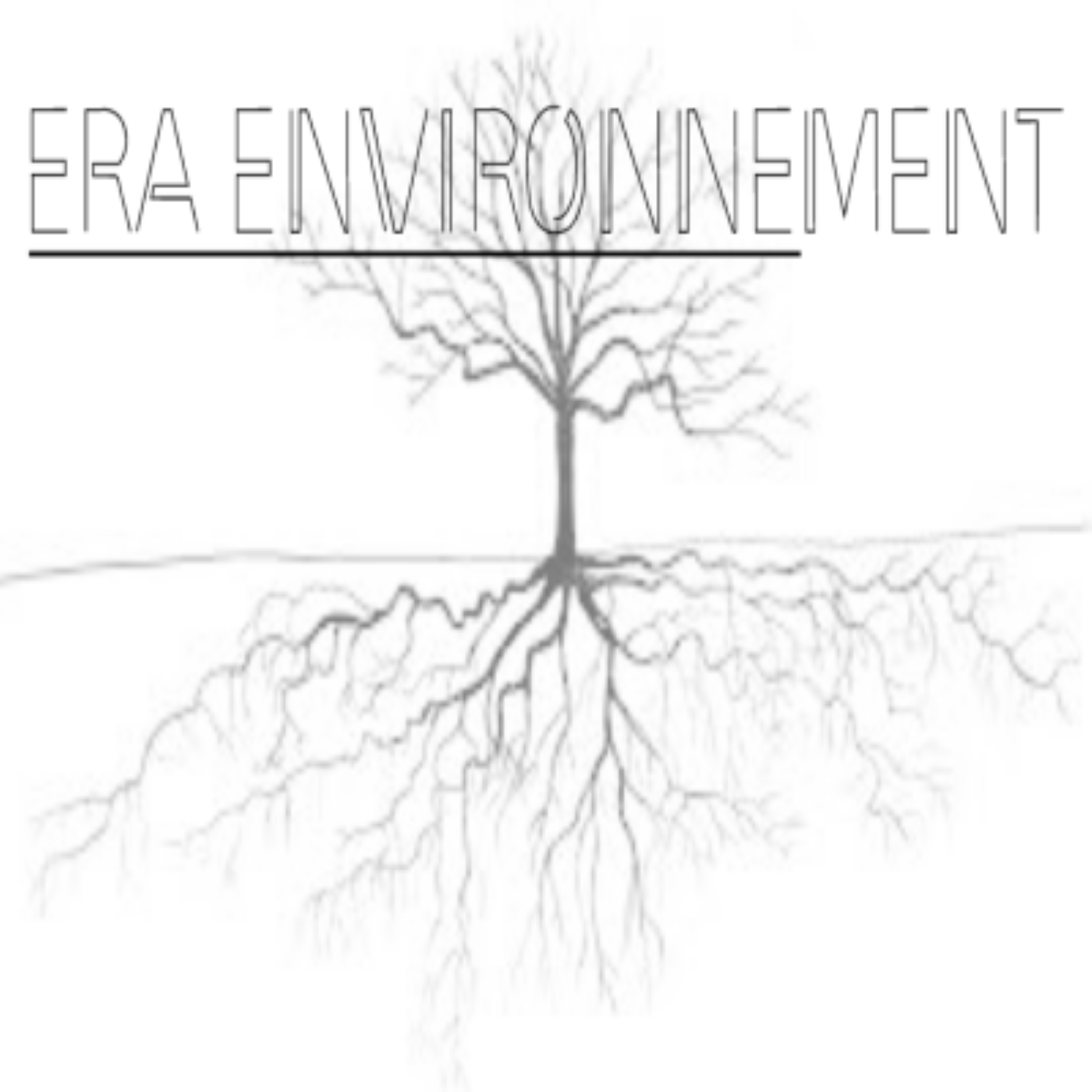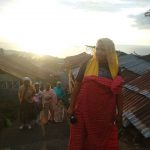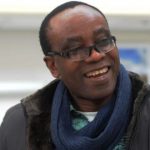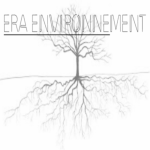
Comorian Coastal areas, after Cyclone Kenneth
In Comoros, 7 people died and 19,300 people were displaced because of the tropical Cyclone Kenneth happened from Wednesday 24th to Thusday 25 th of April. Most of the agriculture and coastal areas were affected by the strongest tropical cyclone of the archipelago’s history. The risk of water-borne diseases has increased in Comoros countries due to damage to water and sanitation infrastructure, acccording to United Nations Office for the Coordination for Human Affairs (OCHA). Six health facilities were reportedly impacted, including the El-Maarouf National Hospital Centre, two regional hospitals in Foumbouni and Mitsamiouli ( Grande Comore, ), two health posts in Mkazi and Tsinimoichongo ( Grande Comore)as well as a health centre in Nioumachoua ( Moheli) , according to a rapid assessment conducted on 26 April and confirmed by World Health Organization. Known as one of the best places to visit in Comoros, Mitsamiouli has seen part of its infrastructures, trees, and homes destroyed by the cyclone. Report by Houmi Ahamed -Mikidache
Mitsmiamiouli, northern Comoros
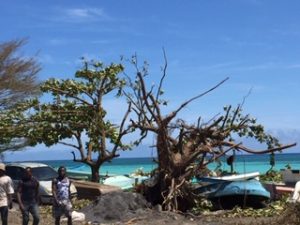 Saturday April 27, Roukia, 28 years old, is sitting in the public bus, the “taxi brousse” in Gare du Nord in Moroni ( the capital of Comoros). Gare du Nord is the place where she used to take the bus after working many hours as a laboratory technician in hospital El Maarouf, the national hospital of Comoros. For the first time since the Cyclone came to Comoros, she can go to her mom’s place in Mitsamiouli. ” Everyone is safe, except the house, the roof disappeared,” she said. The bus leaves Moroni. Roukia is looking around. It’s been three days since the Cyclone came to Comoros. She could not come to her mom’s place before. “The roads were blocked by fallen trees, “she explained. She looks to the windows of the bus. ” This is first time I saw all these trees fallen in the street on my way to my mom’s place, ” she added. The bus passed through many localities which have been damaged by the storm. Finally, one hour later, Roukia arrived in Mitsamiouli. Fishermen are sitting behind the sea. Mitsamiouli is one the towns in the north of Grande Comore which has been hardly demolished by the cyclone.
Saturday April 27, Roukia, 28 years old, is sitting in the public bus, the “taxi brousse” in Gare du Nord in Moroni ( the capital of Comoros). Gare du Nord is the place where she used to take the bus after working many hours as a laboratory technician in hospital El Maarouf, the national hospital of Comoros. For the first time since the Cyclone came to Comoros, she can go to her mom’s place in Mitsamiouli. ” Everyone is safe, except the house, the roof disappeared,” she said. The bus leaves Moroni. Roukia is looking around. It’s been three days since the Cyclone came to Comoros. She could not come to her mom’s place before. “The roads were blocked by fallen trees, “she explained. She looks to the windows of the bus. ” This is first time I saw all these trees fallen in the street on my way to my mom’s place, ” she added. The bus passed through many localities which have been damaged by the storm. Finally, one hour later, Roukia arrived in Mitsamiouli. Fishermen are sitting behind the sea. Mitsamiouli is one the towns in the north of Grande Comore which has been hardly demolished by the cyclone. 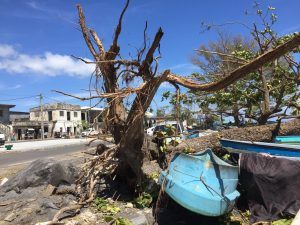
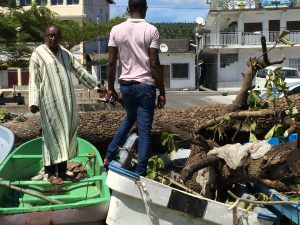
Listen to the interview of Shabaan Mohamed Mfwaraya in Comorian and French.
The Fishermen in Mitsamiouli
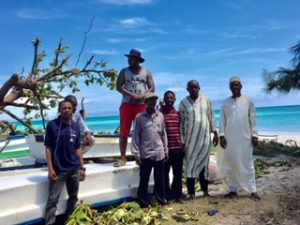 Fisherman Shabaane Mohamed Mfwaraya is standing behind the sea with others fishermen, in the center of Mitsamiouli, in the north of Grande Comore. This experienced fisherman said people in his town did not believe the cyclone will come. ” We were informed earlier by the Civil Security Division,” he emphasized. No firsherman went to the sea the day of the cyclone. His speedboat moored on the beach was destroyed by the cyclone. “Four of our boats were demolished, included mine”he said . He does not know how he will work during the period of Ramadan, the muslim month of fasting. He does not have any insurance and he has to pay a loan for the purchase of his boat every month to the Meck, the comorian micro credit institution. He is a member of a fishermen association. But… he explained: ” Our association is only used when we are lost, otherwise we do not used it.” The World Bank has implemented a project called SWIOfish on sustainable fisheries in Comoros but for Mr Mohamed Mfaraya, this project does not exist in his town. The president of the Union of Comoros, Azali Assoumani came to see them on friday 26th and he said comorians citizens will have to pay 10% of their salary to help people affected by the disasters in Comoros. A day after the cyclone, the comorian president said in a press conference that the United Nation System and its partners can support Comoros, but it depends on their decision. On sunday 29th, the United Nations (UN) informed it will grant Mozambique and the Comoros Islands $13 million in emergency funds to help provide food and water and repair damage to infrastructure.
Fisherman Shabaane Mohamed Mfwaraya is standing behind the sea with others fishermen, in the center of Mitsamiouli, in the north of Grande Comore. This experienced fisherman said people in his town did not believe the cyclone will come. ” We were informed earlier by the Civil Security Division,” he emphasized. No firsherman went to the sea the day of the cyclone. His speedboat moored on the beach was destroyed by the cyclone. “Four of our boats were demolished, included mine”he said . He does not know how he will work during the period of Ramadan, the muslim month of fasting. He does not have any insurance and he has to pay a loan for the purchase of his boat every month to the Meck, the comorian micro credit institution. He is a member of a fishermen association. But… he explained: ” Our association is only used when we are lost, otherwise we do not used it.” The World Bank has implemented a project called SWIOfish on sustainable fisheries in Comoros but for Mr Mohamed Mfaraya, this project does not exist in his town. The president of the Union of Comoros, Azali Assoumani came to see them on friday 26th and he said comorians citizens will have to pay 10% of their salary to help people affected by the disasters in Comoros. A day after the cyclone, the comorian president said in a press conference that the United Nation System and its partners can support Comoros, but it depends on their decision. On sunday 29th, the United Nations (UN) informed it will grant Mozambique and the Comoros Islands $13 million in emergency funds to help provide food and water and repair damage to infrastructure.
Comoros’s Economy and climate change
The Comoros archipelago is made up of four islands: Grande Comore, Anjouan, Mohéli and Mayotte. Mayotte remains French Territory despite persistent calls for the re-unification of the four islands by the Comorian civil society and by Comoros Authorities. The cash crops, vanilla, ylang ylang and clove account 90 percent of the country’s total export. Comorian economy is mainly based on agriculture, fisheries and livestock and the islands’s forests are suffering from the consequenes of deforestation which is the seconde leading cause of global warming.
Climate Change is affected Comoros with impacts such changes in rainfall levels and patterns, subsequent shortening of rainy seasons, increased temperatures, sea level rise, an increased frequency of climatic hazards such as droughts, episodes of heavy rainfall, flooding and tropical cyclone as Kenneth now. “Climate change does not cause tropical cyclones, but it exacerbates the impact,” said World Meteorology Organization Secretary-General Petteri Taalasg ahead of a global conference on Multi-Hazard early warning to be held next week . Exacerbating these climate change impacts are part of Small Island Developing States (SIDS), vulnerabilities. Small Island States are indeed vulnerable to natural disasters.
Published May 10
By Houmi Ahamed-Mikidache
